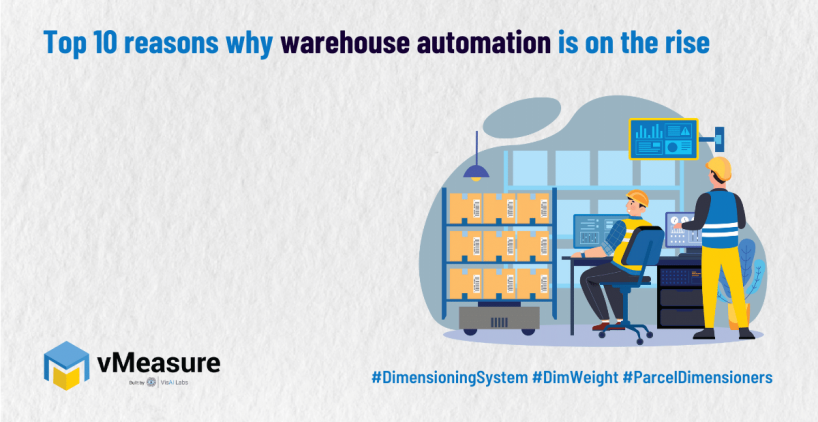Contents
- Summary
- Introduction
- Warehouse Automation- Why They Are Becoming More Popular
- Automation in warehouses is not a novel idea. Why Is It Currently So Popular?
- How can static dimensioning systems optimize warehouse operations?
- Improves warehouse efficacy
- The top ten persuasive arguments for warehouse automation right away!
- Conclusion
Summary
Many warehouse owners struggle to complete last-mile deliveries as quickly as feasible as the eCommerce market grows. In addition, due to the large volume of online orders, there is a problem with order delivery.
For last-mile delivery to run well, businesses must implement technology in their warehouses and fulfillment centers.
This blog post offers ten compelling justifications for why warehouse automation is becoming more popular among business owners.
Introduction
Today eCommerce warehouse and logistics firms are growing by leaps and bounds. As a result, several warehouses and logistics firms face labor scarcity and tone downed productivity. To overcome these issues, these eCommerce firms need to bring automation into the workspace. To take the edge off the labor adequacy gap, eCommerce businesses must revamp their working paradigm by incorporating automation into their workstations.
Warehouse Automation- Why They Are Becoming More Popular
Consider a scenario in which intelligent robots work on various warehouse operations, such as picking, slotting, cartonizing, and moving pallets and packages from one location inside the warehouse floor to another. What is your best estimation of how long it will take to automate the warehouse fully? Possibly in 2030? No, it’s the automated warehouse of today. In 2017, more than 13% of warehouses started integrating automated warehouse solutions to workstations, according to a recent report. This ratio is expected to rise in the coming years to 15 times.
Automation in warehouses is not a novel idea. Why Is It Currently So Popular?
Because of rising expenses and operational challenges brought on by escalating client demands, warehouse automation is becoming a more widely known word.
The following are the three primary causes of the current increase in popularity of warehouse automation:
Increasing property and labor costs
When a business decides to grow, it either hires more warehouse workers or plans to buy more space. Therefore, as the land value increases year after year, the application of automation becomes increasingly desirable. Automating the warehouse allows us to reduce worker perks, including paid time off, seasonal labor spikes, overtime changes, and health care. We also use warehouse automation to run efficiently around the clock with less maintenance.
Increased customer expectations
Customers now expect immediate assistance when they need it as the eCommerce sector continues to grow. Therefore, we must provide them with a tailored shopping experience along with same-day and next-day shipping alternatives if we want to grow the business. Additional client expectations that we can meet include security, in-depth product information with verified user reviews, the ability to create various bespoke discounts based on the order, and 24-hour customer assistance.
More regular and complex order requests
Nearly all eCommerce sectors are currently dealing with enormous order request waves. As a result, the warehouse should standardize the workflow to manage last-mile deliveries. To accomplish process regularization, businesses must properly integrate warehouse automation into their working environment.
Modern warehouse automation strategies that drive more profitability
We can solve labor shortages, warehouse storage needs, and inventory management by implementing warehouse automation. According to a recent report, the online retail sale of physical goods is expected to reach $500 billion, increasing the demand for warehouse services.
Below are a few warehouse automation solutions that empower the modern warehouse:
Static dimensioning system
The AI-based static dimensioning system makes it easy to swiftly measure dimensions like length, width, and DIM weight of shipments of assorted sizes. These static dimensioning systems come in two types: static parcel dimensioning system and Static package dimensioning system. The static parcel dimensioning systems are made to calibrate the DIM weight and dimensions of small and medium-sized parcels. On the other hand, static package dimensioning systems are designed to measure the DIM weight and dimensional information of large-sized and irregularly shaped packages.
This static package dimensioning system effectively accommodates order fulfillment, 3PL, distribution, and warehousing facilities. Additionally, we can integrate other devices like label printers, barcode scanners, and weighing scales with these static dimensioning systems to complete numerous warehouse activities at once.
How can static dimensioning systems optimize warehouse operations?
The three novel approaches to employing the static dimensioning system to optimize warehouse operations are as follows:
Increase productivity
May you believe that a static dimensioning system can reduce manual dimensioning from 17 seconds to 1 second? It is true! With automated parcel dimensioners, there is no room for error since you can quickly dimension any form of the parcel. Additionally, this can greatly increase your productivity and save time and money.
Organizing slotting and maximizing storage
Warehouses have a finite amount of space, as you may be aware. However, if distribution networks and warehouse racking aren’t adequately planned, both the amount of space needed to store the product and the number of personnel on hand will tremble. By integrating automated parcel dimensioners into their processes, an excellent warehouse manager may ensure that their warehouse space is utilized to the most extent possible.
Your warehouse management system (WMS) and any static dimensioning systems will work together flawlessly to give your staff access to real-time data on the size and weight of incoming packages. In addition, because the measurement data is logical and adaptable, your warehouse staff will be able to slot products quickly and effortlessly.
Improves warehouse efficacy
The technology in the warehouse will have an enormous impact on warehouse quality. Since insufficient warehouse operations force the firm to increase its employees to maintain good standards, this is one of logistics organizations’ most important business priorities and differentiators.
On the other hand, increasing the workforce frequently causes lower profit margins and increases the risk of human mistakes in the warehouse system. As a result, many warehouses turn to automation for technologies that speed up routine processes and reduce errors to get through this barrier.
Static dimensioners can significantly reduce the time spent measuring packages and parcels while also reviving warehouse productivity.
Autonomous robots:
According to the new projections, investments in warehouse robotics increased by 57 percent in the first quarter of 2020. This trend is envisaged to gain momentum in the years after the pandemic outbreak. Autonomous robots use sensor technologies to carry out various tasks, such as efficiently sorting, lifting large objects, and moving products around in warehouse environments.
Warehouse drones
Advanced algorithms were used in designing the AI-powered warehouse drones, which carry out a variety of tasks, including inventory management, inventory management, surveillance, and roof and floor identification.
The top ten persuasive arguments for warehouse automation right away!
A topsy-turvy warehouse facilitates a not-good-enough client experience. With the automated warehouse, we can quickly complete several warehouse operations within a projected time.
The top 10 reasons why warehouse automation is increasing are listed in the listicles below:
Reduced human errors
There is no way to wipe out human mistakes. However, we can ease human errors with the appropriate automation. Therefore, 75% of the operation must be automated as part of warehouse automation to free up the remaining 25% for value-added work by warehouse staff.
Improve warehouse performance and analysis
To improve warehouse quality, you must first thoroughly assess the problem areas. To do this, you must initially build an indicator that contrasts the warehouse’s practices with those of similar facilities. Then, by adding the necessary automation, you may increase your warehouse’s production.
Outstanding quality management
Strong quality can significantly alter things! By incorporating quality control into your warehouse, you may reduce the number of defective goods and find accuracy issues before the consumer.
Enhanced information security
Huge importance is given to security at the warehouse. Everything should be correctly aligned in terms of risk. By implementing warehouse solutions, avoiding manual data input procedures, enhancing regular communication, employing remote technology, and routinely inspecting warehouse equipment, among other things, we may polish information security.
Reduced shipping costs
We can greatly increase the effectiveness and operation of the warehouses and save shipping costs with suitable warehouse automation, such as an automated dimensioning system.
Expanded accuracy in order fulfillment
eCommerce is receiving more orders. Therefore, companies should work to ship and deliver goods quickly if they want to succeed. In addition, the warehouses and distribution facilities should also make the appropriate automation investments to streamline order fulfillment in their workplace.
Enhanced warehouse throughput
Warehouse throughput refers to the procedure of sorting and transferring a large number of units through your warehouse, whether during stocking, inventory, or order fulfillment. We may effectively boost warehouse throughput by implementing an appropriate warehouse system.
Decreased costs for handling and storage
Managing many materials might be expensive. We may prevent this by employing a number of crucial planning strategies, such as increasing storage space, minimizing contact time, utilizing developing technology, and increasing warehouse productivity.
Decreased stockout events
A shortage of a commodity is a sign that it is selling well in the market. However, viewing it differently will reveal that it invariably experiences revenue losses. To avoid running out of stock, you may estimate demand, automate the inventory process, and set a re-ordering level that works for you.
Increased customer satisfaction
Your warehouse’s efficiency is a sneaky way to boost sales and customer loyalty. Effective warehouse and inventory management benefits your customers and your firm because no other component of the business can equal the warehouses’ influence on reaching consumers, reducing product costs, and boosting quality standards.
Conclusion
In 2020, the worldwide warehouse automation market will have grown by more than 40%, bringing in more than USD 12.5 billion. However, there are no pre-made warehouse automation solutions; each system is customized to meet each client’s unique needs. As a result, warehouse automation will set the newest benchmark in the next year.
Are you planning to automate your warehouse? Then, deploying static dimensioning systems would be perfect beginning for incorporating automation in your workspace. Click here to learn more about the vMeasure static dimensioning system.



